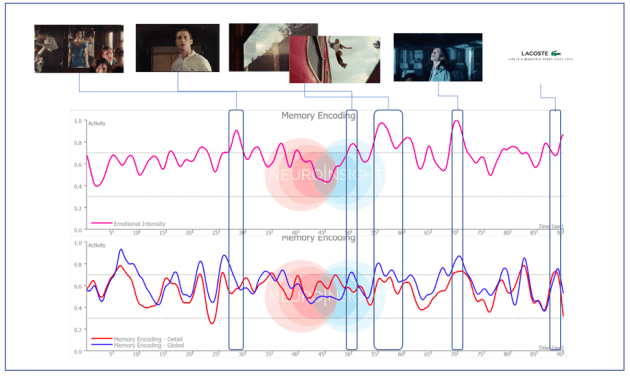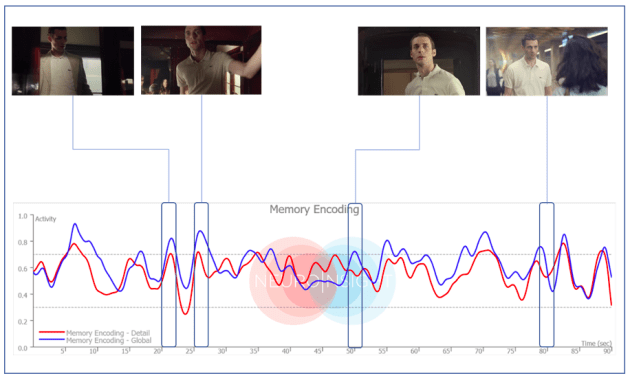
For the eighth year running, Neuro-Insight has teamed up with AdNews to unlock the brain’s take on creativity, by taking a deeper look at some of the Cannes award winners from this year. The Tide ad was first aired during the 2018 US Super Bowl and has gone on to win a Gold Lion in the film category.
Neuro-Insight measured and analysed brain activity to see how female and male viewers responded to this ad. The specific technology used by Neuro-Insight is founded in work originally developed for academic and neuroscience research and has been previously used to analyse the effectiveness of Cannes award winners for over eight years in partnership with AdNews.
Our approach
Neuro-Insight technology allows us to record viewer’s second-by-second changes in approach (like) or withdraw (dislike), emotional intensity, engagement and memory as they watch an ad.
The measure Neuro-Insight predominantly focusses on, based on its strong and highly-researched link in influencing consumer behaviours is long-term memory encoding. This measure reveals what the brain is storing (or encoding) into conscious and unconscious long-term memory.
Neuro-Insight’s memory encoding graph reveals how elements of the ad are stored in long-term memory. The higher the graph, the more strongly that moment in an ad is stored in memory and the more likely it will influence consumer behaviour.
“Timeless drives a strong emotional response”
The ad opens on a crowed train French train station in the 1930s where we see the two protagonists accidently bump into each other and for a moment, intensely lock eyes. As they begin to move away, they intently stare at each other for one last time and we are left with the impression that this is another missed opportunity at true love. But this is only short lived, as the male protagonist changes his mind, chases after the train and franticly search for his love once on board.
Therefore, it is not unsurprising that the combination of an arpeggiated bariolage in the soundtrack and visual style during these early scenes set a strong emotional tone of the ad.
To identify precisely what scenes are responsible for driving the emotional response, we focus on our emotional intensity measure to identify what imagery drove the strongest levels of emotion. This metric reflects the overall strength of the emotion, regardless of whether that emotion is positive or negative. The higher the graph, the stronger the emotion is.
Figure 1: - Lacoste Timeless is in the top 22% of All TVCs globally for emotional intensity.
It should be noted that this is a very difficult response to build and maintain in any piece of creative, let alone a 90 second storyline. The Lacoste ‘Timeless’ ad ranks within the Top 22% of NI’s global benchmarks on emotional intensity. Its ‘shape’ – the steady building/ramping of emotion towards the final scenes is also quite rare in TV advertising.
As the ad starts, we see the levels of emotion rise in unison with the narrative, with the first major peak occurring when the female protagonist is finally found on the train. Not surprisingly, this moment is also met with a similarly strong memory encoding response. The further use of jump cuts to convey the feeling of a frantic movement through the train and time also in turn, helps maintain the levels of emotion as the narrative progresses through to its climatic end.
Figure 2 – Emotion and memory encoding during key moments.
The later peaks in emotion unsurprisingly occur during pivotal moments in the narrative – (see above image). The first of these peaks occurs when the viewer sees the male protagonist running and jumping onto the moving train. Coupled with the screaming train horn and marked change in the soundtrack, this scene not only elicits strong emotions, but also a very strong memory encoding response.
Similarly, a few moments later we see another large spike in both emotion and memory encoding, this time when our female protagonist finds herself alone on a modern, empty train. Symbolically, this scene is very important in the narrative as it marks the end of the journey through time and undoubtedly leaves the viewer with questions about the future of the couple.
Great ad, but was it effective?
One of the most important indictors for advertising effectiveness is the level of memory encoding at final branding and/or integrated branding throughout a storyline. Memory encoding in the Lacoste ad closely follows the narrative, with the large peaks occurring later in the narrative and aided by the harmonic uplift in soundtrack.
There is a large reduction in memory encoding when the couple finally meet and embrace that occurs just before branding. This pattern is something that we have termed as conceptual closure and is a common feature in most ads. Briefly, conceptual closure occurs whenever the brain detects the conceptual end of a narrative.
In this case, the final embrace of the couple after running through the ages effectively concluded the narrative. conceptual closure is not a sign of failure, but simply the way the brain processes experiences.
The subsequent use of the train whizzing past in the foreground is strong enough to retrigger memory encoding briefly which allows the Lacoste end frame to receive adequate levels of memory before another Conceptual Closure sets in.
While, the levels of memory encoding reach peak levels during final branding, it isn’t ideal that conceptual c3losure sets in so rapidly. However, given that the Lacoste polo is featured so prominently during the narrative and is central to many of the most strongly encoded moments identified below,we would argue that this make ‘Timeless’ a very effective piece of communication.
Figure 3: - Apparel branding in storyline.
The verdict
Overall, we would judge Lacoste’s 'Timeless' to be a very effective piece of communication, that weaves the right amount of emotion and branding within narrative. Given the brain responses to the ad, it’s no surprise the campaign came home with two silver Lions this year.
Have something to say on this? Share your views in the comments section below. Or if you have a news story or tip-off, drop us a line at adnews@yaffa.com.au
Sign up to the AdNews newsletter, like us on Facebook or follow us on Twitter for breaking stories and campaigns throughout the day.








